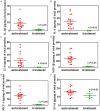The roles of vitamin B12 and vitamin D in children with intractable epilepsy
- PMID: 25785055
- PMCID: PMC4358510
The roles of vitamin B12 and vitamin D in children with intractable epilepsy
Abstract
Epilepsy is a chronic neurological disorder. Antiepileptic drugs (AEDs) can cause vitamin B12 or D deficiency in children with intractable epilepsy. In this study, we measured salivary superoxide dismutase (SOD) and metalloproteinsases (MMP) levels in the patients with vitamin B12 and vitamin D treatment. Cytokines and chemokines were measured using ELISA. The mean salivary value of SOD activity in the control group was 1.75 ± 0.21 U/ml. In the treatment group, the value was 1.33 ± 0.18 U/ml. The salivary MMP 2, MMP 3, and MMP 9 levels of the patients with vitamin D and vitamin B12 treatment were lower than that in the patients without vitamin D and vitamin B12 treatment. Interleukin 1β (IL-1β), IL-6, IL-8, macrophage inflammatory protein 1β (MIP-1β), monocyte chemoattractant protein-1 (MCP-1) and IFN-inducible protein 10 (IP-10) were significantly decreased in the cortex of our patients with vitamin D and vitamin B12 treatment. In this study, a clear association between vitamin D and vitamin B12 treatment and epilepsy was identified. We now plan to investigate the genetic factors that underlie vitamin D and vitamin B12 treatment in patients treated with AEDs.
Keywords: MMP; Vitamin D; antiepileptic drugs; cytokines; vitamin B12.
Figures




Similar articles
-
Temporal dynamics of inflammatory cytokines/chemokines during sofosbuvir and ribavirin therapy for genotype 2 and 3 hepatitis C infection.Hepatology. 2015 Oct;62(4):1047-58. doi: 10.1002/hep.27971. Epub 2015 Aug 22. Hepatology. 2015. PMID: 26147061 Free PMC article.
-
Newer anti-epileptic drugs, vitamin status and neuropathy: A cross-sectional analysis.Rev Neurol (Paris). 2017 Jan-Feb;173(1-2):62-66. doi: 10.1016/j.neurol.2016.09.008. Epub 2016 Dec 2. Rev Neurol (Paris). 2017. PMID: 27919463
-
Effect of vitamin D3 on chemokine expression in pulmonary tuberculosis.Cytokine. 2012 Oct;60(1):212-9. doi: 10.1016/j.cyto.2012.06.238. Epub 2012 Jul 15. Cytokine. 2012. PMID: 22800603
-
Homocysteine plasma levels in patients treated with antiepileptic drugs depend on folate and vitamin B12 serum levels, but not on genetic variants of homocysteine metabolism.Clin Chem Lab Med. 2013 Mar 1;51(3):665-9. doi: 10.1515/cclm-2012-0580. Clin Chem Lab Med. 2013. PMID: 23382314
-
The relationship between pro-resorptive inflammatory cytokines and the effect of high dose vitamin D supplementation on their circulating concentrations.Int Immunopharmacol. 2013 Nov;17(3):693-7. doi: 10.1016/j.intimp.2013.08.010. Epub 2013 Sep 3. Int Immunopharmacol. 2013. PMID: 24007780 Clinical Trial.
Cited by
-
Impact of Vitamin D and IL-1β on Quality of Life in Pediatric Drug-Resistant Epilepsy.J Multidiscip Healthc. 2024 Nov 25;17:5571-5581. doi: 10.2147/JMDH.S493116. eCollection 2024. J Multidiscip Healthc. 2024. PMID: 39619161 Free PMC article.
-
Metalomics Revealed that Changes of Serum Elements were Associated with Oxidative Stress-Induced Inflammation of Cortex in a Mouse Model of Autism.Biol Trace Elem Res. 2025 Aug;203(8):4296-4307. doi: 10.1007/s12011-024-04501-0. Epub 2024 Dec 28. Biol Trace Elem Res. 2025. PMID: 39733022
References
-
- Folbergrová J, Kunz WS. Mitochondrial dysfunction in epilepsy. Mitochondrion. 2012;12:35–40. - PubMed
-
- Loscher W, Schmidt D. Modern antiepileptic drug development has failed to deliver: ways out of the current dilemma. Epilepsia. 2011;52:657–678. - PubMed
-
- Hanai T. Quality of life in children with epilepsy. Epilepsia. 1996;37:28–32. - PubMed
-
- McEwan MJ, Espie CA, Metcalfe J, Brodie MJ, Wilson MT. A systematic review of the contribution of qualitative research to the study of quality of life in children and adolescents with epilepsy. Seizure. 2004;13:3–14. - PubMed
-
- Linnebank M, Moskau S, Semmler A, Widman G, Stoffel-Wagner B, Weller M, Elger CE. Antiepileptic drugs interact with folate and vitamin B12 serum levels. Ann Neurol. 2011;69:352–359. - PubMed
LinkOut - more resources
Full Text Sources
Research Materials
Miscellaneous
